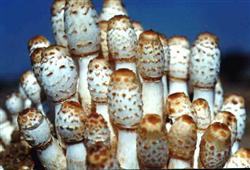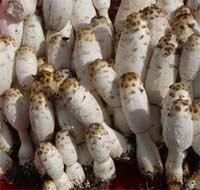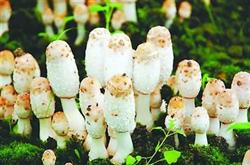Imitating Wild cultivation techniques of Coprinus comatus

The growth temperature of imitating wild Coprinus comatus is between 10 ℃ ~ 24 ℃, and the mushroom is produced from March to June in spring and from September to November in autumn. If imitating wild cultivation in plastic greenhouse, seeds can be sown from October of that year to March of next year, mushrooms can be produced from November of that year to June of next year, and can be produced twice a year. 5-6 crops of mushrooms can be produced in each cultivation cycle, and the biological efficiency can reach more than 300%. The output is high and the benefit is good. Production process construction of mushroom shed → preparation of culture material → culture material construction fermentation → bagging sowing → bacteria management → bag covering soil → mushroom production management → suitable harvest time. The construction of mushroom shed open land, wasteland and shade can all be used as the field of mushroom shed construction. The construction of the mushroom shed is the same as the vegetable greenhouse, and the idle winter warm vegetable greenhouse can also be used. The mushroom shed area is 30 square meters for every 500 kilograms of dry material. Prepare 1000 kg corncob, 100kg wheat bran, 30kg bean cake, 30kg lime, 30kg phosphate rock powder and 20kg gypsum. The culture material is first dry mixed, then wet mixed, the corncob is crushed before mixing, and the culture material is layered and piled after pre-wetting, so that the water content reaches 70%. After pre-wetting the culture material, the heap with width of 1.5 meters, height of 0.6 meters and unlimited length was built. Turn the pile once a day, spray a small amount of water to the heap surface before turning, and spray water to ensure that there is no dry material. When turning the heap, turn the material from the center of the reactor to the surface, and the material from the surface and bottom to the center of the reactor. The temperature of the stack can rise to 60 ℃ ~ 80 ℃ from the second day, and the fermentation period is generally 5 to 10 days. The successful fermentation material has a large number of white actinomycetes, no sour and ammonia taste, dark brown and sweet flavor of fermentation material. Bag sowing each bag with 5 layers of bacteria and 4 layers of material, first with 1 layer of material, and then with 1 layer of bacteria. Break the strain into walnut-sized pieces and try not to break the strain. Pack 1 layer of material and 1 layer of bacteria, then seal with a pin. Bagging should pay attention to the appropriate tightness. After sealing at both ends of the bag, punch a hole in each end with a wooden stick with a diameter of 3 cm. Before October, the temperature in the mushroom shed was relatively high, when the bacterial bag was discharged with a layer on the ground, leaving a gap of 3 cm between the bag and the bag, and the bacteria could be carried out in the mushroom shed. After October, 3 layers were arranged on the ground, and 4-5 layers were arranged after December to form a bacterial wall, leaving a gap of 10 cm wide between rows, and the bacterial wall was covered with wheat straw 10-20 cm thick. Several thermometers are inserted into the bacterial bag, and the temperature is recorded once in the morning and once in the evening. During the sterilization period, the temperature in the bag is controlled at 20 ℃ ~ 30 ℃. If the temperature is higher than 35 ℃, there is a risk of burning bacteria. When it reaches 40 ℃, the hyphae will be burned for 2 hours. The temperature of the bacterial bag can be controlled by uncovering the plastic film and adjusting the vent. The mycelium can grow in the bag about 20 days after the bag is covered with soil. According to the habit that Coprinus comatus does not touch the soil and does not produce mushrooms, the hyphae can be removed and covered with soil 3-5 days after the mycelium grows in the bag. Before covering the soil, pour water through the ground of the mushroom shed, then dig down 15 centimeters, remove the good bacteria bag from the plastic bag and arrange it vertically in the dug border. If the bag is too long, it can be cut from the middle. The border is 1.5 meters wide and unlimited in length, fill the gap with the row, and finally cover the soil with a thickness of 2 to 3 centimeters. The humidity of the soil should be grasped by hand and scattered as soon as you touch it. Add 2% lime when covering the soil, cover the soil with plastic film, keep the temperature at 14 ℃ ~ 25 ℃, and bud mushrooms after 15 days of culture. The mycelium development of mushroom management has entered the stage of reproductive growth, which is mainly managed by temperature regulation, humidification, ventilation and proper light. It is appropriate to control the temperature of mushroom production at 12 ℃ ~ 22 ℃, spray water and ventilation every day, keep the relative humidity of the air in the mushroom shed between 85% and 95%, and ensure that the air is fresh, causing the hyphae to kink and form mushroom buds. It takes 7 to 12 days for the fruiting body to mature. Harvest at the right time when the bacterial ring at the edge of the fruiting body cap begins to loose, and when the stipe is still tight, it should be harvested in time. When harvesting, hold the lower part of the stalk with your hand and gently rotate it to pull it out. After harvest, clean up the mushroom root, spray heavy water once, cover with film, and culture for 10-15 days, the second stubble mushroom can be produced, and the management of the second stubble mushroom is the same as that of the previous stubble.
- Prev

The benefit of making good use of space is doubled to grow Coprinus comatus under black fungus.
Distiller's grains is a good raw material for edible mushroom cultivation, and its nutrients are suitable for the growth of Coprinus comatus hyphae, which can not only reduce the production cost of Coprinus comatus, but also prevent environmental pollution. Distiller's grains contains a small amount of ethanol and active yeast which are harmful to mycelium growth, the acidity is high, and the pH value is 3-5. So choose fresh distiller's grains.
- Next

Methods of harvesting and dry processing of Coprinus comatus
Coprinus comatus, also known as Pleurotus ostreatus, is a typical medium-temperature breed, which can not produce mushrooms normally when the ground temperature is lower than 8 degrees Celsius. When the ground temperature is higher than 30 degrees Celsius, the mycelium vitality decreases, a large number of parasitic bacteria appear, and Coprinus comatus is close to the end of harvest. Adopt the method of cooling in summer and increasing temperature in winter, Coprinus comatus can be produced every year, but in summer.
Related
- Fuxing push coffee new agricultural production and marketing class: lack of small-scale processing plants
- Jujube rice field leisure farm deep ploughing Yilan for five years to create a space for organic food and play
- Nongyu Farm-A trial of organic papaya for brave women with advanced technology
- Four points for attention in the prevention and control of diseases and insect pests of edible fungi
- How to add nutrient solution to Edible Fungi
- Is there any good way to control edible fungus mites?
- Open Inoculation Technology of Edible Fungi
- Is there any clever way to use fertilizer for edible fungus in winter?
- What agents are used to kill the pathogens of edible fungi in the mushroom shed?
- Rapid drying of Edible Fungi

